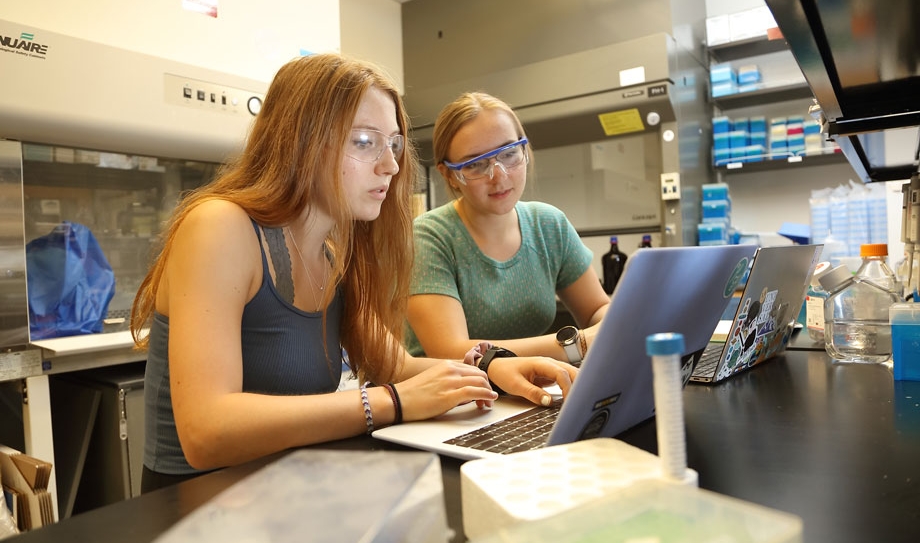Liza Harold and Clare Cocker have a lot in common. They are pursuing engineering at the University of Virginia School of Engineering and Applied Science, are passionate about innovating health care, and represent women utilizing high-performance computing in their common pursuit. Harold, a fourth-year biomedical engineering student, and Cocker, a third-year chemical engineering student, are conducting research in theLampe Biomaterials Groupwith their advisor, associate professor of chemical engineering Kyle Lampe. In the lab, Harold and Cocker have become part of a team that researches and engineers hydrogels, gelatin-like molecular biomaterials used in tissue engineering for medical applications, such as cell or drug delivery.

Hydrogels are made up of molecular building blocks. Some building blocks Lampe’s team is interested in are amino acids that string together to form protein fragments called peptides. How the building blocks are arranged determines the hydrogel’s physical characteristics — meaning researchers can design the material to function in desirable ways if they can understand and harness the underlying chemistry.
On April 4, Harold and Cocker presented their research at the Virginia Women in High-Performance Computing Student Lightning Talks, hosted by Research Computing which is a part of UVA Information Technology Services. Specifically, the duo showed how they are using highly complex computer modeling, called molecular dynamic simulations, in their individual research projects to model and predict the folding, bonding and assembly of peptides to better understand how they could be used to create customizable hydrogels.
It takes computer architectures with state-of-the-art processing power, along with specialized software, to run the molecular dynamic simulations. Harold and Cocker perform the work with UVA’s high-performance computing cluster, called Rivanna.
“We use Visual Molecular Dynamics software on UVA’s high-performance computing cluster to simulate a system of peptides that represent a hydrogel,” Harold said. “The analysis of the simulations helps us understand the molecular interactions that are important to how hydrogels form.”
Their research is central to advances in the field of tissue engineering. Findings will inform methods for developing custom hydrogel substances — biocompatible to different types of human tissues — so they can be used as a delivery mechanism in treating different diseases and injuries.
“We can determine how to engineer more advanced hydrogels for tissue engineering using these computational methods,” Cocker said. “The goal is to encapsulate healthy cells into the biocompatible hydrogels that can be delivered into diseased tissues with simple methods, like injection.”
“The healthy cells can then grow into replacement tissue.”
“Liza and Clare’s dedication, independence and leadership have been outstanding. They took on a largely unbounded project and navigated a path to find resources and support to accomplish our goals,” said Lampe, who also holds courtesy appointments in biomedical engineering and neuroscience.
“Since then, they have provided structure and training for a growing team of computationally focused undergrads in our research group, helping them branch out to their own distinct research questions.”
The undergraduate researchers answered an open call for presentations sponsored by the UVA-led Virginia Women in High-Performance Computing, known as VA-WHPC. Member institutions include the University of Richmond, The College of William and Mary, Virginia Tech, George Mason University, Virginia Commonwealth University, Old Dominion University, Virginia Institute of Marine Science and Advanced Cyberinfrastructure Coordination Ecosystem: Services & Support.
Gladys Andino, senior computational scientist at UVA Research Computing, is the founder and chair of the statewide organization that launched in October of 2021.
“Access to high performance computing resources has become increasingly important for research. It is great to see early career researchers demonstrating how those resources make their work possible,” said Joshua Baller who recently joined UVA Information Technology Services as associate vice president for research computing. “I am incredibly proud that Research Computing can partner with Gladys as she builds a statewide community where women in high-performance computing meet and connect.”
Nine additional women researchers from participating member universities presented their research at the virtual student lightning talk.